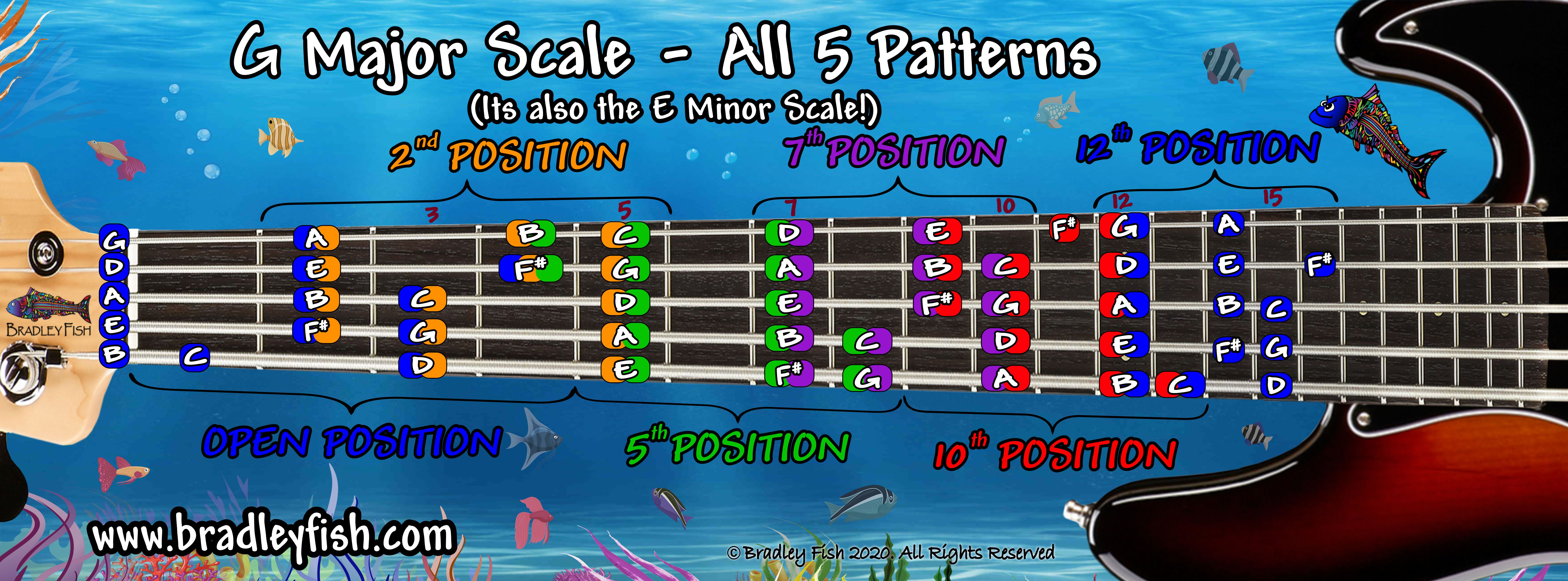
The G Major Scale and E Minor Scale on the 5 String Bass!!
The G Major Scale and E Minor Scale on the 5 String Bass!!
Its also A Dorian, B Phrygian, C Lydian, D Mixolydian, F# Locrian…but hey who’s counting?! 😉
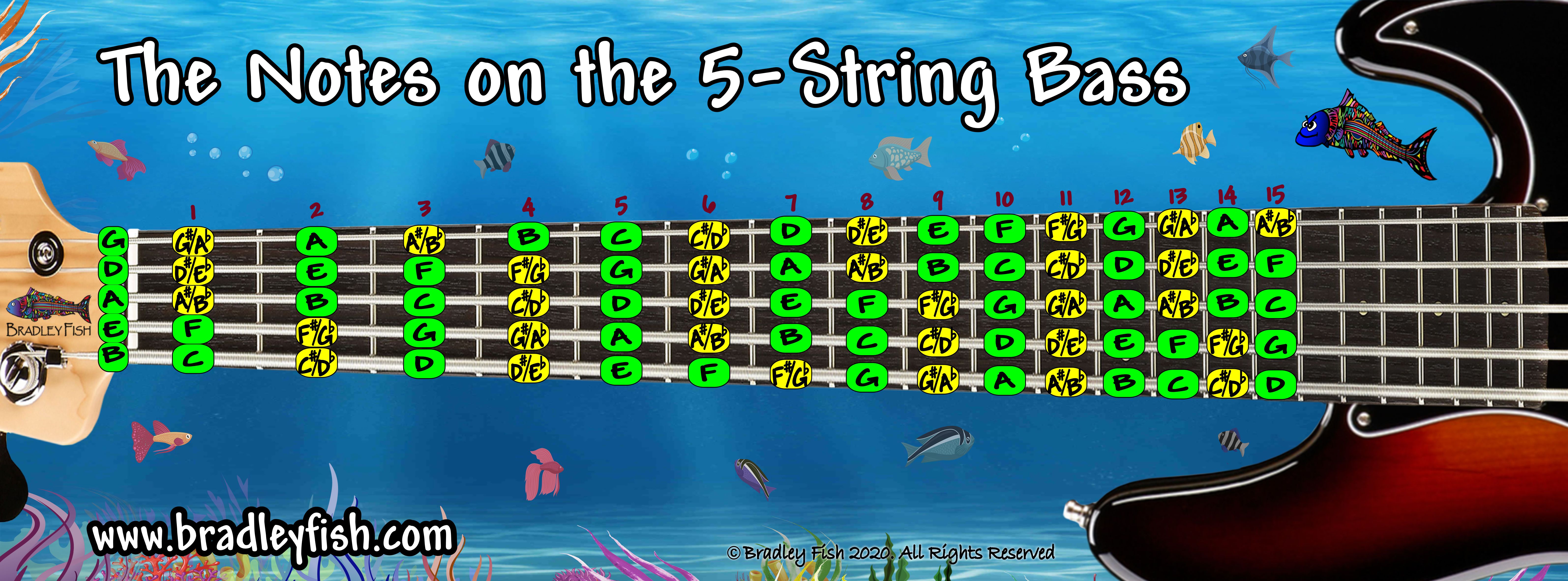
The Notes on the 5 String Bass!! Now in Color!!
The Notes on the 5 String Bass!!
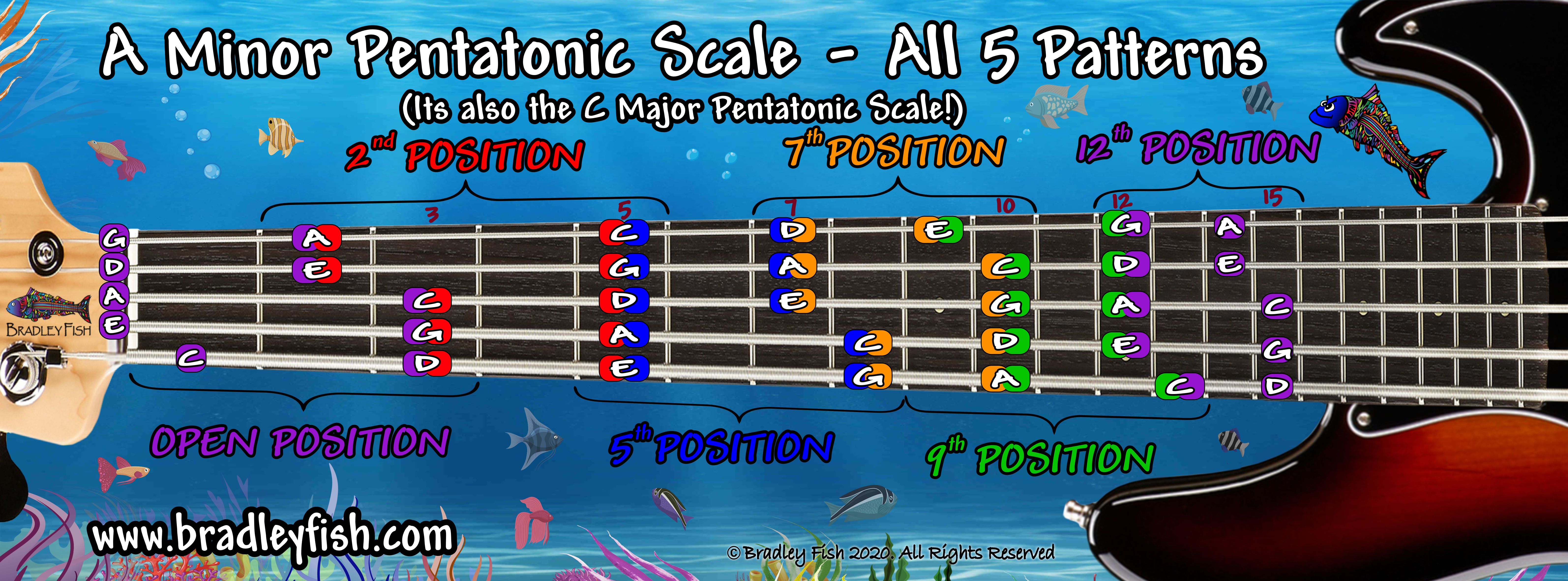
5-String Bass A Minor Pentatonic Scale Patterns
Here’s All 5 of the 5-string Bass A Minor Pentatonic Scale Patterns!!

The A Minor Pentatonic Scale – Also the C Major Pentatonic Scale – All 5 Pentatonic Positions on Guitar!
Here ya go! The A Minor Pentatonic scale gives you a blues/rock vibe (bend the D notes to Eb and back to D). The C Major Pentatonic Scale gives you a country or southern rock vibe (bend the D notes to E). (The vibe will stay the same regardless of key). Its also how Asian instruments like the Guzheng (Chinese Zither) or Dan Tranh Vienamese 16 string zithers are tuned!
Notice all the patterns overlap!! Open and 12th are the same pattern, 12 frets (an octave) apart. Have Fun!!
Here’s the same scale in E minor or G Major: https://bradleyfish.com/the-e-minor-pentatonic-scale/
Open Guitar Chords for Beginners!
Guitar Chords for you!!
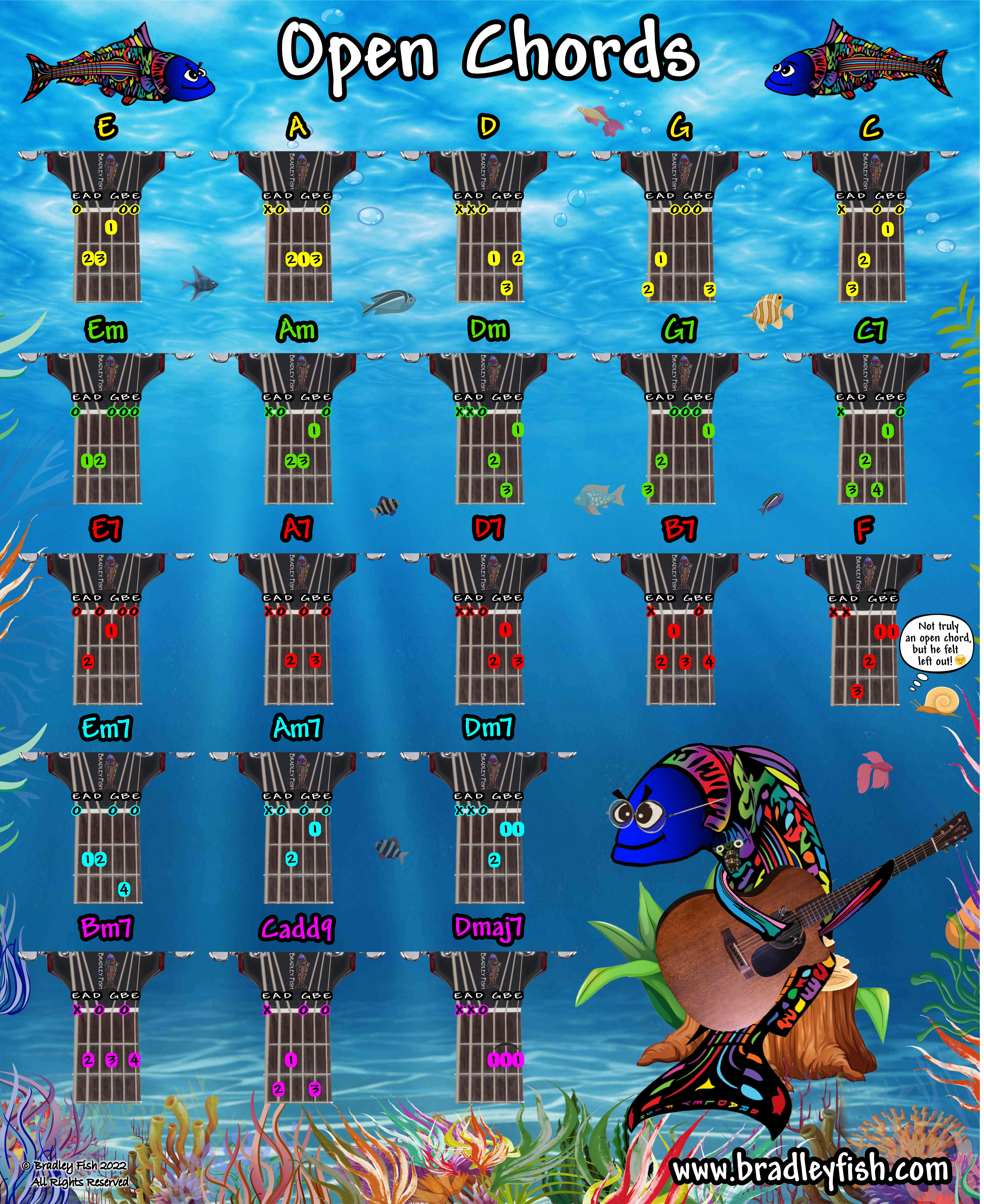
Beginner Guitar Chords
Ukulele Chords!! Starter Uke Chords!! Open Uke Chords!!
Ukulele Chords!! Have fun with your Uke! Here’s a bunch of common uke chords to get you started! UKE!!!!!! Enjoy!!! 🙂
Animated Uke chords at bottom.
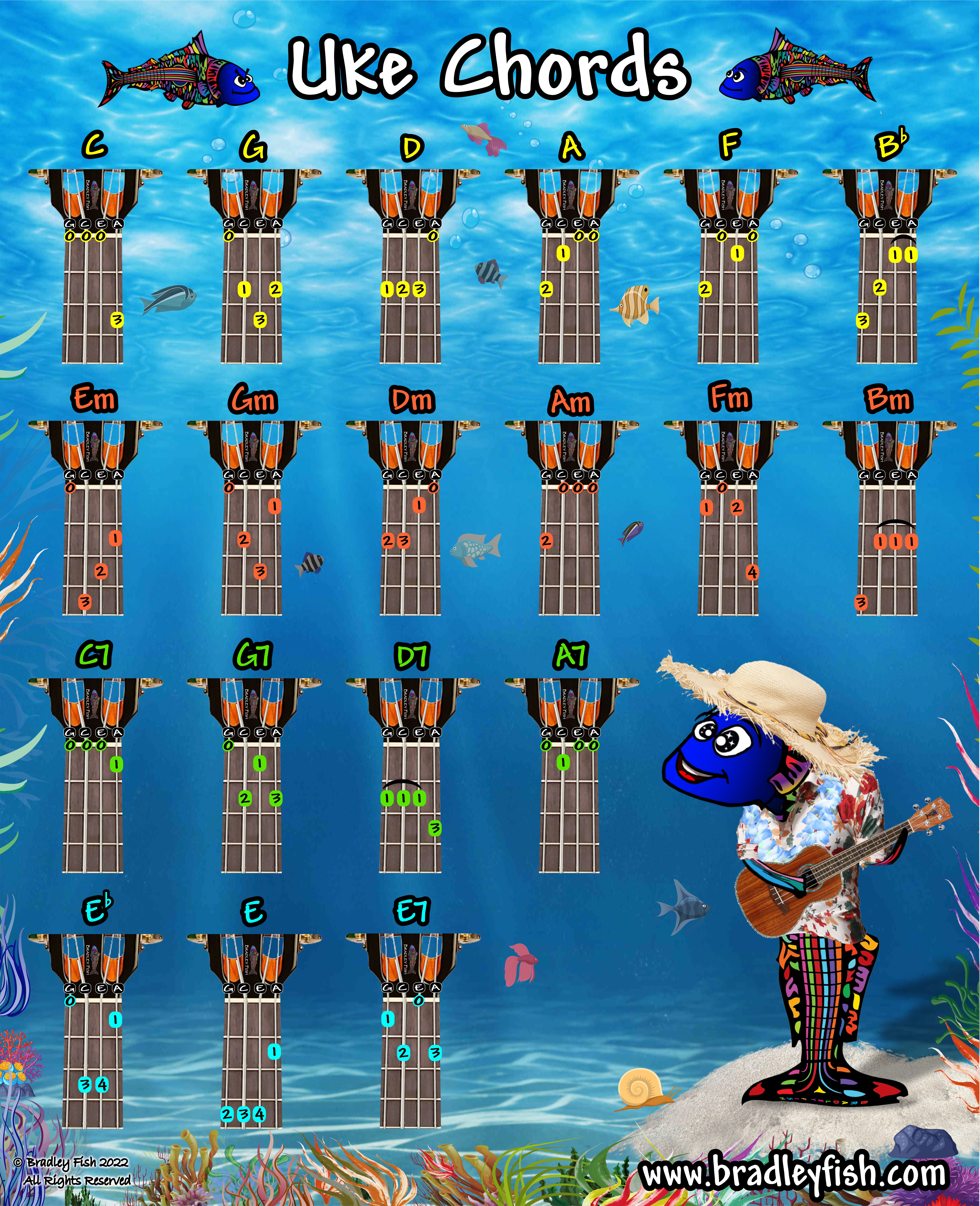

What should I Practice for self-study Guitar/Music?
A question I got asked a lot recently:
What should I practice for self-study guitar?
(Especially while my teacher is taking a break?!!?)
Of course, everyone is different – we all have different musical goals, tastes, experience/skill levels, attention spans, etc…
So later on in this article, I’ll aim to throw TOO many ideas at you, and let YOU decide what to try…As I like to say say, think of this as a buffet…if you like the peas, enjoy…If you don’t like the carrots, leave ‘em…
But first, let’s tackle something I haven’t heard other music teachers discuss:
There’s a surprising amount of ‘rocks stars’, etc that claim that they never practice.
They just play…
And they’re probably being pretty honest…
But they DO rehearse w/their band, write songs, record multi-track parts in the studio, play gigs, pick up their axe and play for fun/noodle, sit in and jam with other bands/musicians, do paid session work, learn new tunes they like, work out ideas, produce beats/music, learn from other musicians/music teachers, etc, etc…
And they get really, really good at playing through those playing experiences.
Now if you want to be able to shred a zillion notes a minute, or do more complex styles of music like classical, jazz, or super fast Hungarian Death Metal (did I just make that up?) , you’re going to need to practice – probably a lot.
I read that Jerry Garcia from the Grateful Dead used to spend 4 hour hours a on tour day running scales. He needed to for that music.
John Coltrane (famous jazz sax guy) spent at least twice that much time doing his scales and arpeggios, etc daily…Again he needed to for the music he was creating.
Some musical styles have almost an almost athletic component that requires some repetitive, disciplined practice…
But if you’re more of a singer/songwriter type, or into say, post punk or grunge or folk, pop, blues, or a of of classic rock…its a different ballgame. Until you try to go for more advanced level lead playing in those genres, and even then, a lot of your practice can be fun playing…
Kurt Cobain may not have been soooo technically proficient as Nirvana’s frontman. But he had enough chops to do what was needed for that music. And he had the artistry — the lyrics, the attitude, the emotional delivery, the songwriting, etc – to really make it work. If Cobain would have spent all of his time running scales up and down the fretboard, waiting to be ‘good enough’, it would have backfired. Instead he wrote super cool, fairly simple songs, played a zillion gigs, and got into the studio to make albums. And he did a LOT in a short lifetime, with the abilities he had.
With all that said you certainly have my encouragement to play your guitar (or whatever axe) a lot and just enjoy — or have a very regimented guitar practice — or a mix – its totally up to you. Experiment.
Whatever you do — try often (or at least sometimes) to play to a beat or metronome while you play/practice…
I’ve had new students come in (you know you you are lol!) who had already learned beautiful pieces from other lessons….but they couldn’t play at a consistent tempo…and it was a train wreck… Until they fixed it by playing to a beat/metronome. And then it sounded and felt awesome… Be honest. If that’s you…add a beat (Loopz, GarageBand etc) to your practice / playing regimen. Crank it up — You’ll improve quickly and massively.
if you are practicing more ‘seriously’…
Its totally up to you whether you structure your practices on a tight schedule in 27.3 minute intervals — or just drink lots of coffee and do it in the middle of the night between Netflix binges lol…
I’m not the most disciplined person, probably a little ADD (a strength for artists, btw)…In pre-historic times, when I was doing a jazz guitar degree, us long haired guitar majors (yes I had hair once lol) used to congregate in the music school practice rooms and work together on our latest assignments, often in marathon 8+ hour sessions…
It was partially out of terror that we’d be called up in front of the class to play and partially because it was kinda fun and we could feel ourselves getting better through the process…
What we practiced was mostly dictated by that weeks’ assignment, mixed with a bit of whatever we found interesting…
I’ve taken a lot of of the most useful of of those assignments – from the perspective of someone into more popular music – rock, country, pop, blues, reggae, etc— and given them to my students — I hope over time to turn them into blog posts and videos too (there’s a few vids out there already)…
Ok, now for a ton of practice ideas:
Projects are great and make for some of the best Practice. Gigs, Studio Recordings, Videos – Isn’t this what music is all about?! Great shows, awesome albums?!
I noticed that my students that join my rock band and acoustic band classes just get better, at a solid pace or even quickly…there’s something about the real or imagined social pressure of just being around other humans — even though everyone is super nice and non-judgemental — that just magically makes them improve when they jam in those classes..
Playing in a group develops important skills that you won’t get practicing 1 on 1 — listening, musical dynamics, musical interactions and cues, fitting into a groove, playing sparsely, knowing when to play what, improvising based on real-life interaction, etc…
So Jam w/ people! Join a band, Find a friend to play with, hit a local jam session — get a little out of your comfort zone. Play. Enjoy. Bring Pizza. Have Fun! You’ll get better quickly and probabaly have a blast in the meantime.
Btw, some of my students are jamming together while classes are off for the winter. I LOVE that!
OK, in no particular order…here’s a lot more ideas for you to try, at your leisure…
Plan to Play LIVE at an open mic, talent show or a house party or an actual Gig, etc — look for opportunities — and use that partial fun/partial terror (lol) as fuel for your practice. Video record yourself on your phone, etc during practice and while performing – watch it, take notes. Do it again… Then play live again….
Record (anything) multi-track.
If you’ve never done this, its not trivial – more than I can cover here…but if you have…Lay down a beat (a drum loop, your beat, whatever) at a solid tempo (i.e. w/the built-in metronome) – then play rhythm guitar, sing, add lead guitar, add a bass, a kazoo, whatever, have fun.
Your rhythm playing will tighten massively and your lead playing will improve like crazy though this feedback loop of playing and listening…Enjoy being in ‘the studio’!
Do a Live Video – even on your phone. Play guitar (and sing!) Do a few takes, pick the best one and send it to Mom for her birthday! Do a cover — or even better, write or improvise the song!!
Just pick up your guitar and ‘noodle‘ and have fun. I do it all the time..Improvise.
Do the previously mentioned noodling, but with a beat on. (or a metronome for more advanced players).
Write a (%%^&*!) song. Just do it. Finish it. Then capture it – even on your phone audio recorder for starters. Extra credit for multi track demos!
Learn New songs – Get a songbook – or search online “my favorite song”, chords — or tab…
Ok.. for some more conventional, and truly useful things to practice.
Scale patterns – learn all of the patterns of the same scale — or try a new scale. Start with the most useful ones (major/minor and major/minor pentatonic) , then get more exotic later. (Better to get 1 pattern well than a bunch sorta — but its ALL good.)
Put on a beat and play a simple chord progression with some space to improv and jam your new scale in between..
Or lay down a loop or a recording of the progression and play lead over it.
Learn Arpeggios – that’s a chord played 1 note at a time. They’re really useful for soloing also.
Try YouTube videos – there’s endless youtube guitar teachers. See if you can find someone you like and pick up some good tips, a new song or concept, etc.
Wacky new scales – check out my fish frets beta app https://fishfrets.bradleyfish.
Here’s a little experimental loop jam I did based on a pentatonic raga called Bhiravi (A 5-note Indian scale) https://www.youtube.com/watch?
Open tune your guitar and experiment – my fishfrets app lists some — or google some — or make up your own! Light the incense and try jamming and writing with these!
Try new axes – drums, dulcimer, piano, slide guitar, bongos, electric or a acoustic or bass — whatever — get adventurous! (Btw, If you have any hand/arm problems, its a nice way to stay musical and use different muscles.)
Work on reading notes – (or Tabs) of new music you find interesting.
Get a good songbook — go through it and explore…
Learn a solo by ear. Transcribe it.
Write your scales/arpeggios out in a notebook.
Get a theory book – learn – try to apply immediately — come in w/ questions…
Jam while chiling – play while hanging w/friends, watching youtube, on the couch etc. I did this a lot in high school…
Play at work if they’ll let you. If you’re a teacher do some songleading…Computer Programmer? Get a quiet electric guitar you can noodle un-plugged during breaks…I get to play guitar at work constantly. 😉
Re-work your old favorite open chord songs with Barre chords.
Run triads up and down the fretboard w/songs you know.
Add licks to songs you’re already playing – bass lines, little rffs, etc
Practice relaxing while you play — drop the death grip! Make being relaxed your #1 priority as you play. Breathe. Use less pressure and better positioning.
Take on a challenge-Try a classical piece or an arrangement of a song that you’ve always loved that’s a real project, and sounds full on guitar.
Learn New strums — google this.
Try New picking patterns — google this
Learn new ‘feels’ — Learn to play reggae, or funk, or speed metal…
Get a free/$1 Ear training app – learn / test on the intervals. This is huge. Try:
https://www.good-ear.com/ You can practice while you’re in line at the grocery store.
Play to Backing Tracks, Youtube has tons like this:
https://www.youtube.com/
Or make your own, or use your looper pedal..
-Handy? Learn how to set-up (lower) the action your instrument from a pro YouTube video. If you’ve never tried extra-light strings, try that.
Have fun!!!
P.S. as I write this, its winter — Remember to humidify your guitar (when the heat or AC is on.) I use a big room humidifier for lots of instruments. They also sell little guitar humidifiers for your case. This is especially important with a more expensive guitar, to protect your investment. If its a cheapy, it still good idea, but not so crucial.
P.P.S As I wrote this article, I thought of lots of video ideas and a few more articles to illustrate these ideas…we’ll circle back later…
‘Do YOU have other practice ideas I didn’t think of?? Please comment below!!! You can also post questions below…
Btw, Please write down your questions for when we meet next — I LOVE it when my students have an agenda!
Lessons start March 18, 2024. I will be reaching out by phone as needed mid march. Hit me anytime at bradleyfishmusic@gmail.com
Thanks – cya soon!
Bradley Fish
217-552-9407

A Minor Pentatonic Scale — All 5 patterns for the whole Bass Guitar — Newer, Prettier, Fishier!!!
Here ya go!! New & Improved! 🙂 A Minor Pentatonic Scale for Bass. Rock This Please.
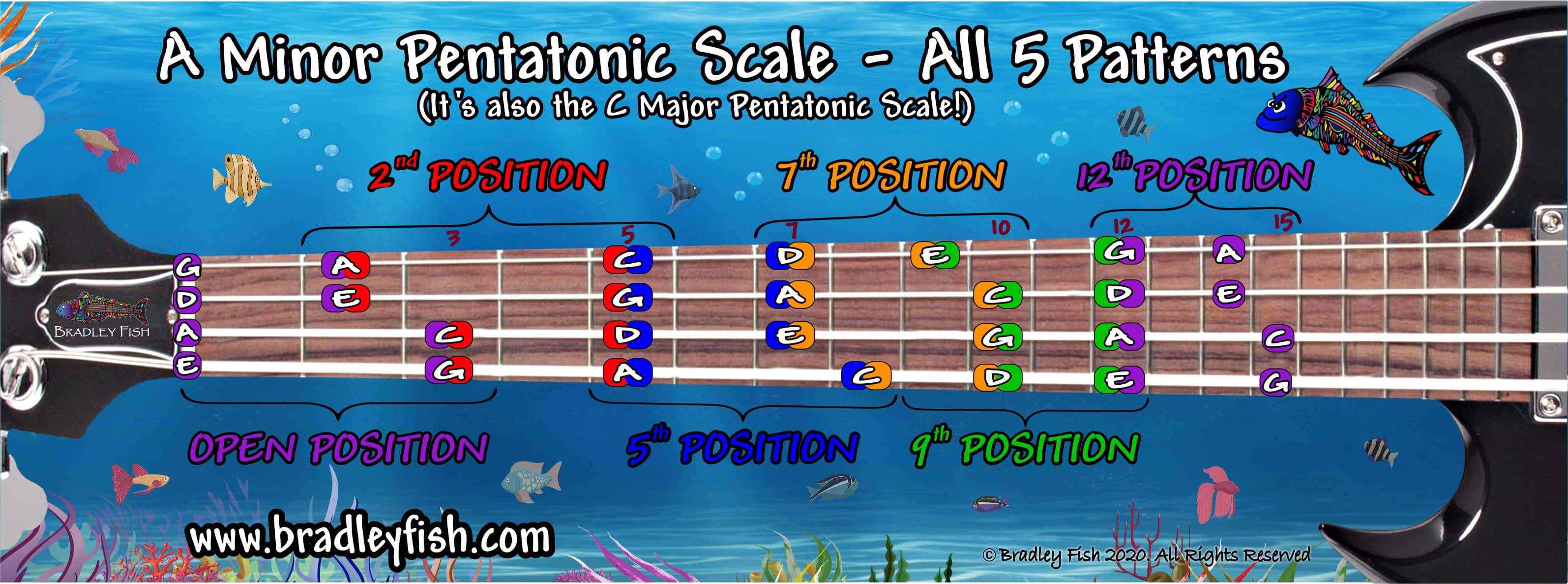

Triads up the Guitar Neck – 3 shapes for endless jamming
So I’m dying to be all Rick and Morty like the last post, but I’ll try keep it focused instead…
There’s 3 shapes on the high 3 strings for all the major chords.
We used D Major here.
Here’s how we got them (Skip to ‘How To Use Them’ – if you really don’t care)
You take a D Major scale (or any major scale for any key) and find the 1st, 3rd, and 5th of the scale. So D = D F# A..
Then you put them in ‘closed position’ order (not skipping notes like 1 5 3 – that’s open position – for later). So we get:
1 3 5
3 5 1
5 1 3
In this chart we start on A (the 5th) for your ‘good ol D chord’ so its the 5 1 3 to start. Next shape is 1 3 5, then 3 5 1. (Btw, we’re color coding like the chart).
You might notice that 1 3 5 shape (middle) looks like (is) the top of a ‘classical’ D barre chord, and the high 351 guy is the top of a slid up F chord shape – or the high 3 strings of a 10th fret rock and roll D barre chord.
How to use them:
Lets take a simple progression of major chords for now (Don’t sweat it, we’ll add minor chords soon).
How about //: G / D / C / D ://
Record this progression for a few minutes to a beat, or Loop it, or have your buddy or girlfriend or even your musical slave from another galaxy (blaming Rick) play it over and over.
Slide each chord around to get the new chords –
If you slide a D down 2 frets – or up 10 – you get C.
If you slide a D up 5 frets – or down 7 – you get G.
(Notice 2 + 10 and also 5 + 7 both = 12. The up/down thing always adds up to the 12 frets in an octave.)
Ok, now use these shapes to play along, You can play 1 or 2 — or more – shapes per measure.
Try picking them 1 note at a time.
You can also add licks to them from the D major scale.
This is a nice way of playing while someone is singing – you can flow up and down the neck – without getting a beer bottle thrown at you by the singer – which might happen if you’re just jamming pentatonic scales while they;re trying to sing.
I have some YouTube videos at where I cover this material and I plan to do more. These skip ahead to future blog posts where we cover more strings, minor, etc.
Don’t worry we’ll get there and I plan to eventually shoot one that just covers this post.
Cya Soon —
Have fun!
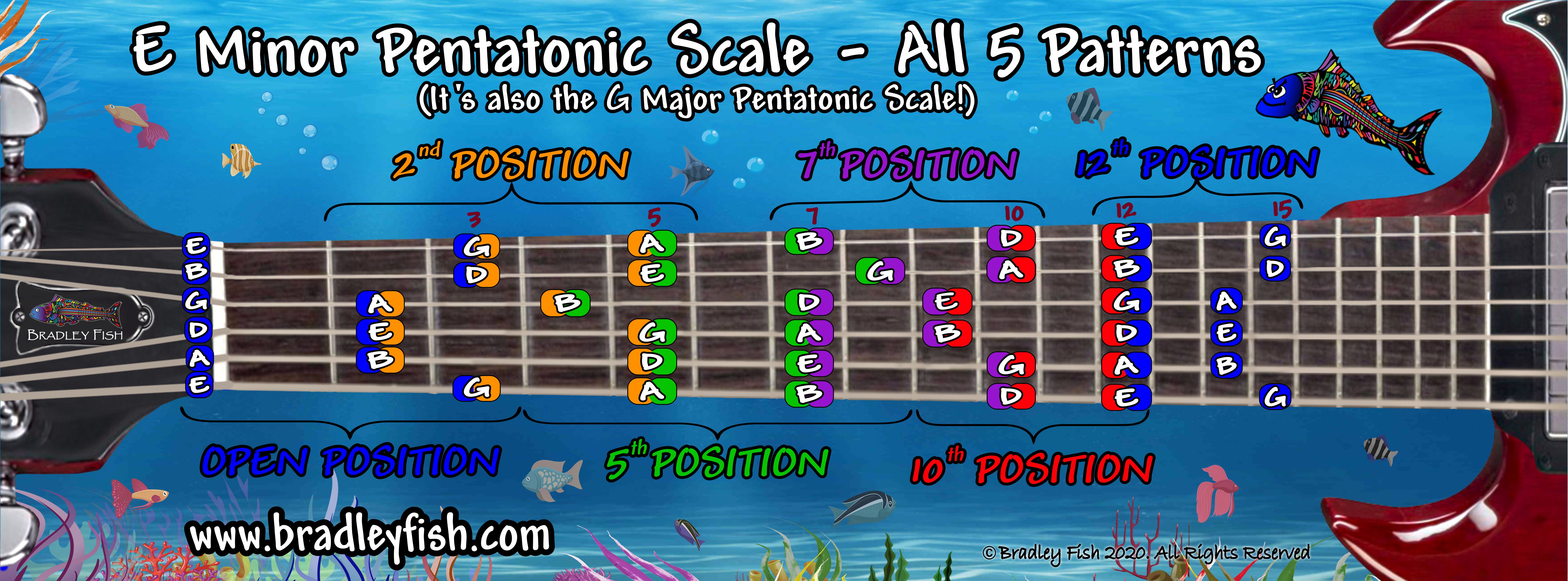
The E Minor Pentatonic Scale
Just rock with this scale. Here’s ALL the patterns. This is it bro. YOU are Jimi. Now go blaze. Crank this through distortion on your Marshall Amp. Play it on a Chinese Gugin. Play it on a Guqin through a Marshall Amp. Turn it up to 11 bro. Just crank. Learn this sh*t. Make sh*t up. Bend the A up to B-flat to sound bluesy. Now go rock.


